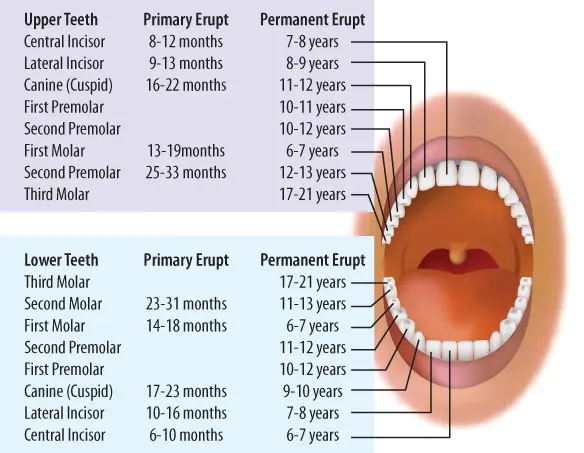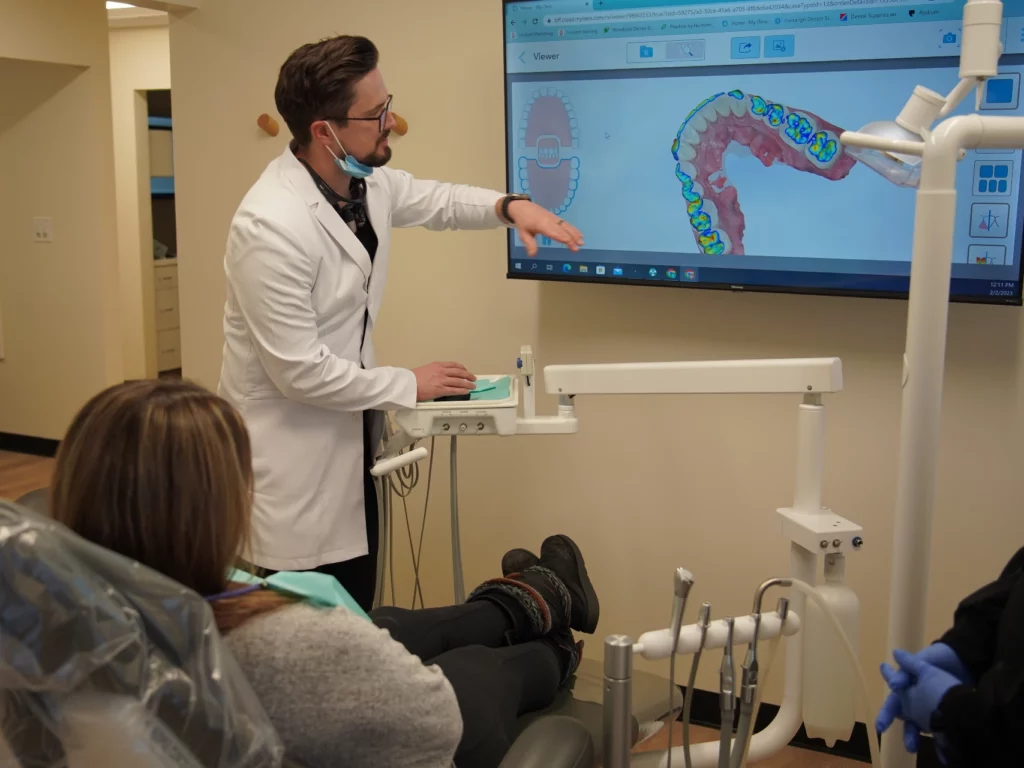Our dentists believe that a trip to the dentist should be fun, lighthearted, and nothing to fear. The way your child is exposed to dentistry lays the groundwork for how they view dental care and dental visits for the rest of their lives.
Our team especially loves caring for young patients, and works hard to make sure each child is spoken to gently, treated with respect, and cared for as if they were our own child. We use simple words to explain procedures to our patients and make sure each parent or guardian is aware of the process as well.
Pediatric dentistry is an essential component of your child’s overall health and wellbeing. Take steps to protect your favorite little grin and schedule an appointment at Woodside Dental Group. You can book online or call (907) 333-1211. We serve families from around the Anchorage, AK area and surrounding communities.

The health of your child’s baby (primary) teeth is very important for a number of different reasons. While your child’s front four teeth only last until they are 6-8 years old, their back teeth aren’t lost until between the ages of 10-13.
The first function of baby teeth is to allow your child to properly eat, chew, and speak. Baby teeth are also essential to help maintain adequate space for the growing permanent teeth and guide them into the right position. Furthermore, neglecting your child’s primary teeth can lead to problems that in turn may affect their developing permanent teeth.
We want your child’s first dental visit to be a positive experience. If your child is old enough to understand, they should be told about their appointment. It is best to not make a big deal out of their visit though…try to treat it as if it is just another normal day. Our team strives to gain your child’s trust so they can have little (if any) apprehension at the dentist.
You should begin cleaning your child’s gums with a soft cloth and water from the time they are born. As soon as their teeth begin to erupt, proper tooth brushing is one of the most important things you can do to help protect your child’s teeth from cavity-causing bacteria. You should use a soft-bristled toothbrush with a small amount of toothpaste (no more than a pea-sized amount) and be sure that your child spits out the excess toothpaste after they are finished. Wherever your child’s teeth touch together you need to floss as well. Those tight spaces often trap food and bacteria, which can in turn lead to the formation of cavities. The grocery store and drugstores such as Walgreens and CVS usually sell children’s floss picks in the dental care aisle. These picks are usually much easier to use than traditional dental floss. In addition to all the above, it is important that you help your child brush his or her teeth. It is good to let them “help,” but young children lack the coordination to effectively brush their teeth on their own.

Your child’s teeth begin forming before they are even born. Most children cut their first teeth (the lower 2 front teeth) between the ages of 6-10 months. Most children have all 20 of their primary teeth by the time they are 3 years old, but the eruption order and timing can vary.
Children’s permanent teeth begin to erupt when they are approximately 6 years old. The first permanent teeth to appear are the first molars and lower front 2 teeth (the central incisors). Adults have 28-32 permanent teeth (depending on how many wisdom teeth develop).
Infants and young children may suck their thumb, fingers, a pacifier, or a variety of other objects. Sucking is a natural reflex that often helps them feel a sense of security and happiness. While it is not a problem when they are younger, sucking habits that continue after a child’s permanent teeth have begun to erupt can lead to problems with proper jaw growth and alignment of teeth (such as crowding and anterior open bite, see photo below). We recommend children stop thumb sucking by the time they are 2-4 years of age.
Sippy cups are utilized as an intermediate training tool between baby bottles and an adult cup. At mealtimes you may fill your child’s sippy cup with liquids other than water (milk, juice, etc.), but throughout the day it should contain water only. Allowing your child to sip on sugary drinks throughout the day can break down their enamel and cause rampant tooth decay.
While some malocclusions (“bad bites”) can be diagnosed and corrected as early as ages 4-6, most orthodontic treatment begins between the ages of 8-12. We recommend children go for their first orthodontic consult around the time they turn 8 years old. While they may still have some of their baby teeth at this point, their hard and soft tissues are very responsive to treatment at this time.
Sealants are a protective coating applied to help “fill in” the deep grooves on children’s back teeth (their permanent molar and premolar teeth). Children often have difficulty keeping these teeth clean due to their limited dexterity and how far back these teeth are in the mouth. In fact, 80% of cavities in children are diagnosed on their molars and premolars. Sealants function to “seal out” food, acid, and decay-causing bacteria in order to help prevent cavities.
Pediatric dentistry is a specialized field of dentistry that focuses on the oral health of infants, children, and adolescents. Pediatric dentists, like Dr. Green, are specifically trained to deal with the unique dental needs and concerns of children, such as tooth decay, gum disease, and developmental issues.
Pediatric dentists provide a wide range of services including regular dental check-ups, cleanings, fluoride treatments, dental sealants, cavity fillings, and other restorative treatments. They also help educate parents and children on proper dental hygiene practices, including tooth brushing, flossing, and a healthy diet.
Pediatric dentists are trained to manage the dental anxiety and behavioral issues that may arise in children during dental appointments, and may use techniques such as nitrous oxide (laughing gas) or conscious sedation to help calm children and make their dental experience more comfortable.
Overall, pediatric dentistry is important for ensuring the oral health and well-being of children and helping to establish good dental habits that will last a lifetime.
Look no further – Woodside Dental Group is a family dental office and we enjoy working with patients of all ages! It’s common for us to see the whole family and we’ll even schedule your appointments back-to-back so you can get your whole family in, out, and on with your day!
Well, we might be a little biased, but we firmly believe that Dr. Green is the best pediatric dentist in the Anchorage area! At Woodside Dental Group, we specialize in pediatric dentistry and would love the opportunity to care for your child’s teeth. Dr. Green will not only take excellent care of your child, but will also emphasize the importance of oral health and help educate your child on the best practices for maintaining a healthy smile into adulthood. Give us a call or book your child’s dental appointment online today!
At Woodside Dental Group, we understand the urgency that a dental emergency can pose…especially when the emergency is for your child. If your child is experiencing dental pain, please don’t hesitate to give us a call. We’ll do our best to see your child ASAP, even if that means coming in after-hours or on weekends whenever possible.
Yes we do! Pediatric sedation dentistry is becoming increasingly common, especially for children who may have anxiety or special needs that make it difficult for them to sit still or cooperate during dental treatment. Sedation can help children relax and feel more comfortable during dental procedures, and it can also help to reduce their anxiety and discomfort.
There are different types of sedation dentistry that can be used for children, ranging from mild forms of sedation, like nitrous oxide (laughing gas), to deeper sedation with oral medication or IV sedation. The type of sedation used will depend on the child’s age, medical history, and the complexity of the dental procedure.
While sedation dentistry is safe and effective, it’s important to note that it does carry some risks, and should only be administered by a trained and experienced dentist, like Dr. Green. Before considering sedation dentistry for your child, it’s important to discuss the risks and benefits with Dr. Green, and make an informed decision based on your child’s individual needs and circumstances.
If your child has a dental emergency, it’s likely better to seek care from a pediatric dentist rather than going to the emergency room (ER) for several reasons:
In summary, if your child has a dental emergency, it’s important to seek care from a pediatric dentist rather than going to the emergency room. Pediatric dentists, like Dr. Green, are trained to handle dental emergencies for children and can provide specialized care that is appropriate for their age and developmental stage.
Our patients are our biggest fans. Here are a few highlights from our public reviews.
Monday
8:00AM – 4:00PM
Tuesday
8:00AM – 4:00PM
Wednesday
8:00AM – 4:00PM
Thursday
8:00AM – 4:00PM
Friday
8:00AM – 2:00PM
Saturday
CLOSED
Sunday
CLOSED
We are happy to answer your questions. Please fill out our contact form and we will get back to you shortly!


